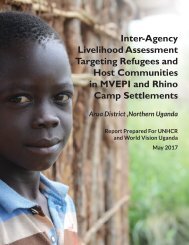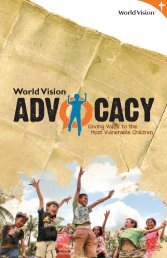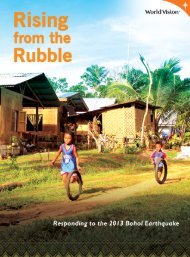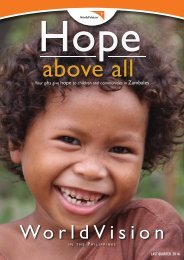SAENER18 Months On Report FINAL (NON-HiRES)
You also want an ePaper? Increase the reach of your titles
YUMPU automatically turns print PDFs into web optimized ePapers that Google loves.
Peacebuilding<br />
T<br />
he SAENER Regional Coordination Unit and the National Offices applied basic principles<br />
such as the Do No Harm/Local Capacities for Peace approach to ensure any assistance<br />
provided to communities did not create or exacerbate tension. The response interventions<br />
were conducted to connect men, women and children, as well as groups of different ethnic<br />
or religious backgrounds to achieve social cohesion. World Vision recognized that bringing<br />
humanitarian assistance especially food resources into an extremely food insecure (and<br />
relatively volatile context) could potentially create conflict or exacerbate existing tensions.<br />
Understanding the culture and context of every community is important. The Response<br />
ensured that practices, initiatives or projects do not conflict with societal structures and<br />
systems. Communal challenges were solved by the communities themselves using localised<br />
systems. Implementation of projects also considered inputs from traditional leaders to<br />
ensure that activities do not have a negative impact on a specific section of the population.<br />
The complaints and response mechanism played a critical role in helping address issues<br />
related to the response. The response worked closely with other stakeholders and community<br />
leaders to ensure that distribution processes were transparent and fair. World Vision took<br />
necessary precautions to ensure that distributions were completed early to give enough time<br />
for beneficiaries and staff to reach home safely. All program updates especially on changes<br />
in food rations were made in a transparent manner. Community meetings were conducted<br />
in an effort to address any pertinent issues that were unearthed through the complaints<br />
and response mechanism and the other monitoring processes. All activities were closely<br />
coordinated with local governments and appropriate line ministries (e.g. Ministry of Health,<br />
Water and Agriculture).<br />
Southern Africa El Niño Emergency Response (SAENER)<br />
18 MONTHS ON REPORT 23










